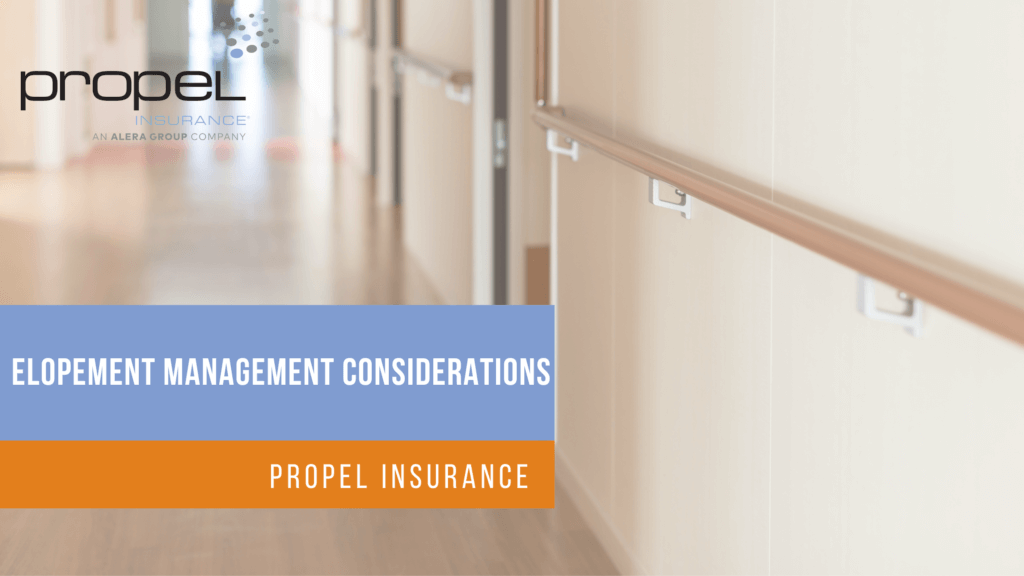Propel provides innovative insurance solutions to thousands of companies across the country. We make it our business to know your world inside and out.
Claims & Risk Management, Insights, Senior Care
Elopement Management Considerations
Elopement can be intentional, “I am going home” or unintentional, “I want to walk outside.” The intent often leads to the resident leaving a safe area for an unsafe one. The risk and the intent should be addressed promptly by assessment and interventions. Understanding the why behind the actions or intent will assist with management of the exposure.
One-half of elopements and associated incidents occur within the first 48 hours of admission to a senior care community. Even residents with no history of exit-seeking behaviors may attempt to leave during the first 72 hours because the location is unfamiliar to them and there may be an acute onset of confusion due to the new surroundings.
There is a difference between aimlessly walking as wandering about and walking with a purpose of leaving the immediate area. Both are a safety concern.
In order to address the risk and the need, Elopement should be clearly defined.
Elopement:
The ability of a resident who is not capable of protecting him/herself from harm to successfully leave the facility unsupervised and unnoticed and who may enter into harm’s way.
Wandering:
Refers to a cognitively impaired resident’s ability to move about inside the facility aimlessly and without an appreciation of personal safety needs and who may enter into a dangerous situation.
The plan of care should address elopement risks and wandering behaviors. Staff should understand the differences between these two behaviors, the associated risk with each behavior and care plan approaches specifically for each behavior.
Resident risks are most frequently identified through clinical style assessments and risk knowledge is confined to documentation within the resident record and care plan which are not available to all staff. Elopement risks need to be communicated to all staff. All employees need to be actively involved in elopement management processes; knowing which residents are at risk for elopement is “need to know” information for everyone. An elopement binder or “hot file” is one method for communicating at-risk residents to staff as well as providing current photographs and resident-specific information that could be retrieved and distributed quickly should an elopement occur.
Elopement drills should include all employees and be conducted at established intervals; at least twice a year with local law enforcement invited to participate when possible. Every drill should be critiqued with the goal of identifying opportunities to improve related processes and strengthen adherence to processes, protocols, and regulatory requirements. Feedback should be sought from employees after each drill and employee education provided in response to any identified concerns. Staff are more likely to respond quickly and appropriately during an actual elopement if they have regularly participated in elopement drills.
Consider the following components of elopement management:
- Develop and implement an elopement management program based on regulatory guidelines specific for the level of care to be provided that includes:
- Elopement risk assessments at admission, quarterly, and with a change in condition or mental status
- Interventions placed promptly to address identified elopement risk and captured on the plan of care
- System to verify census after resident changes in location such as emergent evacuation, emergency preparedness drills such as fire drills, resident activities including activities where family members or members of the local community are present and off campus activities
- Education to staff and family regarding elopement risk and elopement management processes
- Establishment of an elopement binder or “hot file” that is actively maintained and readily available in one or more locations should an elopement occur
- Elopement risk assessments at admission, quarterly, and with a change in condition or mental status
- An assessment of the physical location and installation of security systems and barriers designed to reduce elopement risk and risk of injury to residents with careful consideration to life safety codes.
- Door security
- Limit number of exits with direct access to outside
- Safety locks, numerical keypads, or utilization of fobs that restrict access to the outside or other dangerous areas
- Electronic elopement management system such as “wander guard”
- Perimeter fences
- Functional alarm system for egress and stairwells
- Secured courtyards
- Elevator controls
- Window restrictors that prevent windows from opening greater than six inches
- Measures to reduce ability to access “unsafe” locations on community grounds such as ponds, swimming pools, densely wooded areas
- Door security
- Diversional activities
- Based on level of elopement risk, cognitive impairment, interests, likes and dislikes
- That offer the opportunity to “safely” wander and/or satisfy needs such as the perceived need to retrieve children from the bus stop, perform prior work or home responsibilities
- Consider placing residents at risk for elopement in close proximity to areas where staff are frequently present such as nurses’ stations or employee work stations to increase frequency of opportunities to observe resident
- Create dedicated specialty unit for residents identified as elopement risk when possible
- Camouflage doors and doorknobs with consideration to life safety and regulatory requirements
- Utilize decorations that provide positive distractions and act as deterrents
- Process to review the plan of care of residents at risk for elopement at established intervals to verify that elopement management interventions are being implemented as outlined and meet the current needs of the resident.


